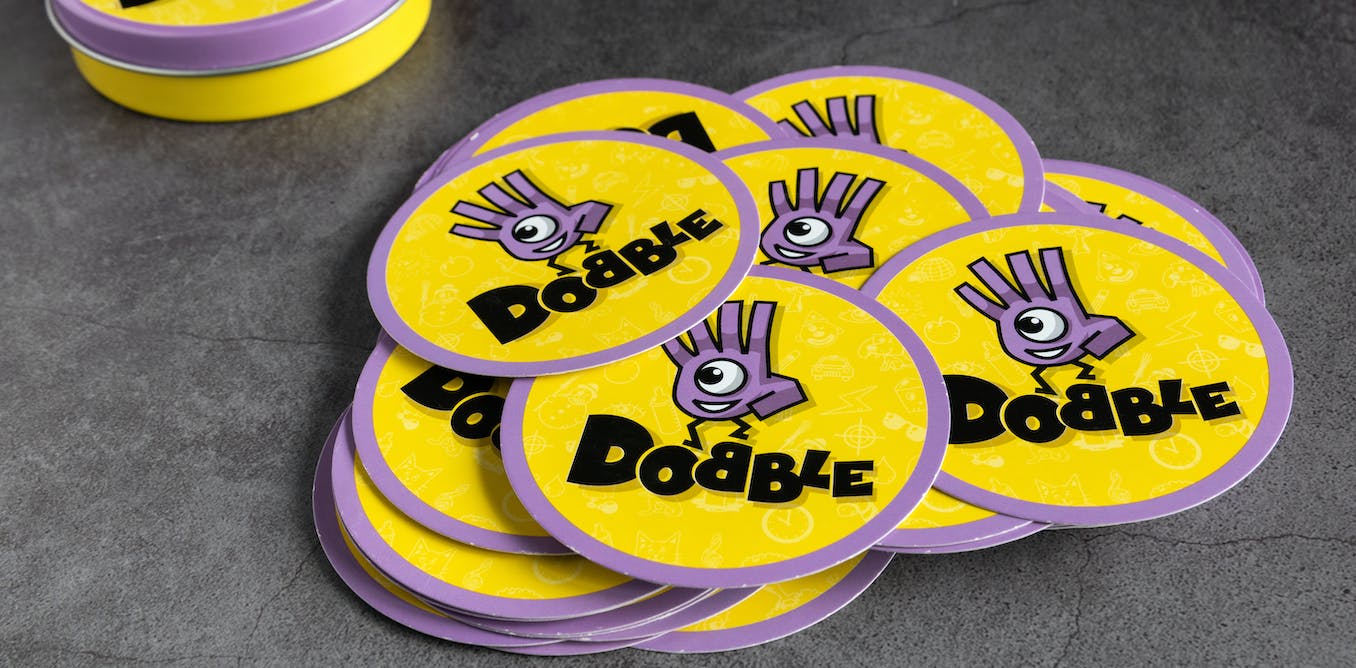Following birthday and Christmas presents, families often have a glut of new games to learn and play. Many of these games involve computers or games consoles, but with concerns about children’s screen time there has been a recent increase in the popularity of traditional board and card games.
One non-electronic card game that has made its way into our homes is Dobble. It’s a game of observation, articulation and speed that was first released in France in 2009.
While the mathematics behind the workings of this game is interesting, as cognitive psychologists we were also fascinated by the underlying cognitive processes that make this simple game so absorbing and challenging to play.
The aim of the game is to be the first player to get rid of all their cards by discarding them one at a time into a central pile. Players do that as soon as they can identify, and announce, the single common symbol between the card in their hand and that on top of the pile.
Players must be quick as the top card will change every time your opponent(s) are able to match and discard one of their cards before you. There are 55 cards, each containing eight symbols out of a possible 57. And in any pair of cards, only one symbol matches.
The first task in the game is to visually search the symbols on both the card in your hand and that on the top of the central pile to find the single match. Colour, size and location are typical cues we use when searching. But this task is more difficult than it seems due to the number and variety of symbols. Their shared features sometimes give rise to false alarms when scanning quickly. For example, the lips, heart, maple leaf and fire symbols are all red in colour.
The fact the target items will likely be of a different size and orientation on each card also means that we perceive the same symbol slightly differently. So a match is more difficult to identify.
Unlike, for example, Where’s Wally?, where the object of the search is clearly defined, with Dobble we do not know on any round which item we are searching for. Indeed, this will be different for each player.
The task requires dividing attention by searching two visual scenes in parallel. And also holding in memory the symbols that you have viewed on one card for comparison with those on the other.
We may switch between different strategies such as scanning the symbols on both cards in the hope that the match will just “pop out”. Or we may adopt a more structured approach where we peruse each symbol in turn.
When demands on attention are high, we are more likely to suffer inattentional blindess. That’s the phenomenon of “looking but not seeing”, whereby the item we are fixating on does not receive enough attention for us to actually notice it.
Say the name
Once you have found the matching symbol you must quickly announce what it is before placing your card down on the pile. This again sounds simple, but, just like producing the correct word in everyday speech, it requires the processes of linking the desired concept – the symbol on the cards – with the name that represents it.
Also, you have to ensure that you select the appropriate word, for example saying “tortoise” rather than “turtle”. Plus you must select the correct sounds to utter that word, before finally saying it out loud. In the urgency of the game, you may find these processes don’t happen as quickly as you want them to.
Claire Adams/Shutterstock
Once you have correctly articulated the matching symbol and played your card, the whole process starts again. Given the low chance of that previous symbol being the next correct match, you must inhibit (stop yourself thinking about) this recent item – its name, its location, even its colour – so that you can be open to a new search. However, you must not inhibit it completely as there is still a chance it could appear next.
Inhibition is also required if your opponent calls out a symbol on their card first. Even if you were about to articulate a match, you must now inhibit this vocalisation and instead restart the search for a new pairing since the reference card in the centre has now changed. This ability to switch between searches and inhibit unwanted information is one of a number of “executive” organisational cognitive processes that help us in the planning and coordination of activities.
Under stress
And of course, all of this occurs under time pressure. Stress can increase when it seems your opponent is discarding their cards quicker. We know that increased stress levels impair our word-finding ability, attention to information, inhibition of responses and ability to adapt to changing circumstances. All of those are vital to performing well in Dobble.
The bad news for parents is that many of the processes we have described decline as we get older, meaning that children may have the competitive edge at Dobble.



